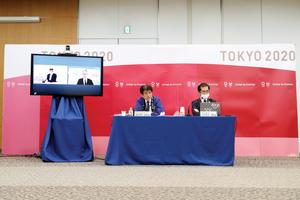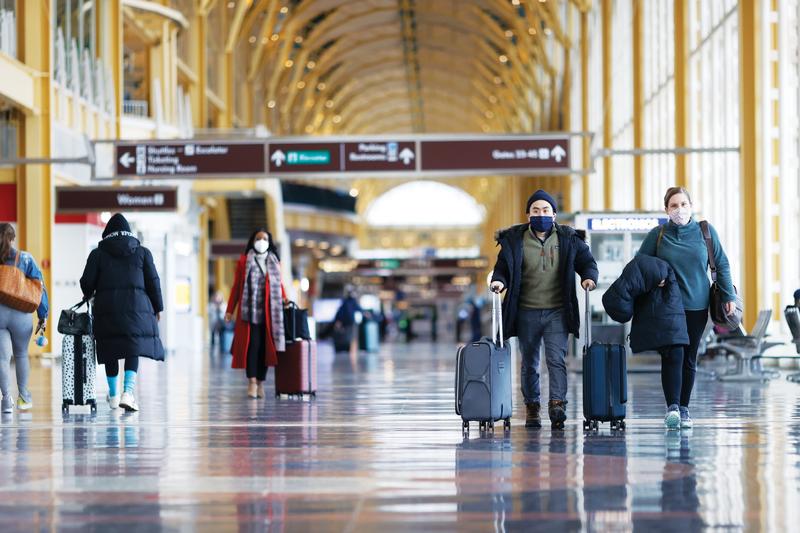 Officials of the organizing committee of the Tokyo Olympic Games release the first of a series of health guides to a safe and successful Games, the Playbook International Federations, on Feb 3. (DU XIAOYI / XINHUA)
Officials of the organizing committee of the Tokyo Olympic Games release the first of a series of health guides to a safe and successful Games, the Playbook International Federations, on Feb 3. (DU XIAOYI / XINHUA)
While helping experts of the World Health Organization conducting research in Wuhan, China also expressed the hope that the US government will also invite WHO experts to carry out novel coronavirus source tracing research in the United States.
Foreign Ministry spokesperson Wang Wenbin made the remarks at a news briefing on Feb 2 after US Secretary of State Antony Blinken said in an interview that China’s arrangements for WHO experts were not transparent.
Since the outbreak of the pandemic, China has always maintained close communication and cooperation with WHO on the source tracing issue in an open and transparent manner, Wang noted, adding that the visit of WHO experts to China is part of the global scientific research cooperation on source tracing. The Chinese government has provided strong support and assistance to this end.
In recent days, WHO experts have had productive discussions with the Chinese side and visited hospitals, markets, the Wuhan Center for Disease, Wuhan Institute of Virology and Huazhong Agricultural University Control. Relevant work is progressing smoothly.
“Chinese experts have shared a large amount of information and research results with their counterparts and conducted several rounds of in-depth exchanges on scientific issues of common concern. WHO and international experts made positive comments on this,” Wang said.
Virus source tracing is a complex scientific issue involving many countries and places which calls for cooperation by scientists from across the world.
A number of clues, reports and studies have indicated that the virus and infections broke out in multiple places globally as early as the latter half of 2019. “WHO should pay similar visits to other countries and regions based on the facts and in accordance with their duties,” he said.
He cited the example of a report by the US Centers for Disease Control and Prevention which says COVID-19 antibodies were found in blood samples from routine blood donations collected in December 2019 in the US.
This means COVID-19 infections may have occurred in the US at that time, earlier than the country’s first official case on Jan 21, 2020, he said.
“It is hoped that the US side will adopt a positive, scientific and cooperative attitude and maintain transparency on the virus source tracing issue, as China has done, and invite WHO experts to carry out source tracing research in the United States, so as to make positive contributions to international anti-epidemic cooperation and scientific source tracing,” he said.
At another briefing on Feb 3, Wang said in response to similar questions: “We hope that following China’s example, relevant parties will act in a positive, science-based and cooperative manner on the origin-tracing issue, invite WHO experts in for an origin-tracing study and shoulder their due responsibilities and obligations for international cooperation in fighting the pandemic and building a global community of health for all.”
In Geneva, Maria Van Kerkhove, the WHO’s technical lead on COVID-19, said the WHO team in China has had “very productive discussions” with Chinese counterparts, visited different hospitals and had a good visit to the seafood market.
“We had some good feedback from them,” she told the virtual news conference on Feb 1 in an update on the team’s progress in the research.
Earlier, the team visited several places including Hubei Provincial Hospital of Integrated Chinese and Western Medicine and Wuhan Jinyintan Hospital, where some of the earliest COVID-19 patients in Wuhan were treated, Mi Feng, spokesman of the National Health Commission, told the media.
Kerkhove said the detailed information the team received requires analysis, which is ongoing between the team and their Chinese counterparts.
Mike Ryan, executive director of the WHO Health Emergencies Programme, is also happy with the scientific process of discovery. “Progress is being made,” he said.
Ryan criticized the comments made by some that they will not accept the team’s report when it comes out and that they may have intelligence that shows different findings.
“I would say, right now, as I sit here, no other countries have provided any documentary, intelligence or other information to WHO,” he said.
“If you have the answers … please let us know,” he added.
It is not responsible “to say you won’t accept a report before it’s even written” and “you have intelligence that has not been provided”, Ryan said, adding that the team in the field deserved international support.
“We are out there looking for it. We are there with experts from 10 countries looking to find answers.”
 Passengers wear masks at an airport in Arlington, Virginia of the United States on Feb 2, following recent US executive orders on wearing masks in public transport vehicles and grounds. (SHEN TING / XINHUA)
Passengers wear masks at an airport in Arlington, Virginia of the United States on Feb 2, following recent US executive orders on wearing masks in public transport vehicles and grounds. (SHEN TING / XINHUA)
Ryan stressed that the international team is mandated by a unanimous resolution of the World Health Assembly, representing 194 countries. “It deserves the support of the international community,” he said.
He said that not that all answers can be found this time, but people who think and say they have information should start providing it.
Ryan noted on Jan 29 that the media contingent following the mission in China is much larger than the international and Chinese teams put together.
“It’s obviously a very good thing that we have that transparency, but it’s also important that we let the team get on with the business of the work they’re doing,” he said.
On Feb 1, the WHO reported that for a third week in a row, the number of new COVID-19 cases globally had fallen. Similar trends are seen in the US, the United Kingdom, India, and in African and Oceanic regions among others.
“There are still many countries with increasing number of cases, but at the global level, this is encouraging news,” WHO’s Director-General Tedros Adhanom Ghebreyesus said.
“It shows this virus can be controlled, even with the new variants in circulation. And it shows that if we keep going with the same proven public health measures, we can prevent infections and save lives.”
As the vaccination campaigns are gearing up across the world, China said on Feb 3 it will provide 10 million doses of COVID-19 vaccines to the global vaccine sharing initiative COVAX to meet the urgent needs of developing countries.
Foreign Ministry spokesman Wang said at a daily news briefing that China is responding to a request from the WHO as developing countries seek to make up for shortages of the vaccines.
The WHO director-general said in January that there needs to be a “collective commitment” within the next 100 days to get vaccinations underway worldwide for health workers and others who are at high risk of contracting COVID-19.
China attaches great importance to Tedros’ appeal and the difficulties facing the practical implementation of the COVAX initiative, in particular the huge vaccine supply gap in February and March, Wang said.
It is another important step taken by China to ensure equitable distribution of vaccines, promote international anti-pandemic cooperation and uphold the concept of a shared community of health for all, he said.
The WHO-led COVAX initiative aims to secure at least 2 billion doses by the end of 2021 and ensure equitable access for 92 low- and middle-income countries that cannot afford to pay for vital supplies on their own. China joined the initiative in October.
“We hope capable countries will swing into action, support COVAX through concrete actions, back the WHO’s work, assist developing countries in obtaining vaccines in a timely manner and contribute to the international community overcoming the pandemic at an early date,” Wang said.
He noted that Beijing is in close communication and cooperation with the WHO to ensure vaccine accessibility and affordability in developing countries.
Speaking at the opening of the 73rd session of the World Health Assembly via video link in May 2020, President Xi Jinping announced that China’s COVID-19 vaccines would be made a global public good.
Since then, the country has been making great efforts to fulfill its commitment. On Feb 1, the first shipment of China-donated COVID-19 vaccines reached Pakistan. The country formally started the drive to administer the vaccines to its front-line healthcare workers on Feb 2.
According to the Foreign Ministry, China is also providing vaccine assistance to another 13 developing countries and will continue to provide such assistance to another 38 developing countries in the next phase.
China has exported large amounts of domestically developed vaccines to countries including the United Arab Emirates, Morocco, Indonesia, Turkey, Brazil and Chile, where clinical studies of Chinese vaccines have been conducted.
It also supports relevant companies in exporting vaccines to countries in urgent need that have approved Chinese vaccines and authorized their emergency use.
Meanwhile in Russia, scientists green-lit the country’s Sputnik V vaccine on Feb 2, saying it was almost 92 percent effective in fighting COVID-19 based on peer-reviewed, late-stage trial results published in international medical journal The Lancet.
Experts said the Phase III trial results meant the world had another effective weapon to fight the deadly pandemic and justified to some extent Moscow’s decision to roll out the vaccine before final data had been released. The results, collated by the Gamaleya Institute in Moscow that developed and tested the vaccine, were in line with efficacy data reported at earlier stages of the trial, which began in September.
Zhou Jin in Beijing and Ren Qi in Moscow contributed to this story.
Contact the writers at wangxiaodong@chinadaily.com.cn


